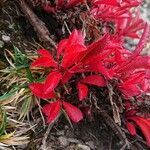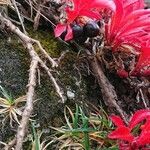Shrubs 3-20(-30) cm; twigs terete, with persistent old leaves or petioles. Leaves: petiole winged, 1-4 mm, ciliate on margins, or hairy; blade obovate to oblanceolate, 4-15 × 0.7-8(-20) mm, base attenuate-cuneate, decurrent onto petiole, apex acute, obtuse, or rounded, surfaces rugose, glabrous or hairy. Inflorescences 2-4(-7)-flowered; bracts ovate, membranous. Pedicels 0.1-0.6 mm. Flowers: sepals pale green or yellow, 0.8-1.2 mm, apex acute; corolla yellow, whitish, or green (pale yellowish green), 3.5-4.5 mm, lobes recurved, greenish, rounded, 0.5 mm, glabrous; stamens 1-2 mm; anthers reddish, becoming yellow, 0.6-0.7 mm, horns 0.1-0.2 mm. Fruits black-purple, 6-9 mm diam. Pyrenes 2.7-4.6 × 2-3.6 mm. 2n = 26, 28.
More
A small shrub. It can lie along the ground or be up to 40 cm high. It spreads 1 m wide. The stems are woody and branching. The leaves are green and oval. They have rounded teeth around the edge. The surface is wrinkled. The flowers are pale yellow and bell shaped. The fruit are small black berries.
It is a temperate plant. It grows in northern China in alpine thickets and among rocks at 1,900-3,000 m altitude. It grows best in sandy, rocky, well-drained soils. It needs a protected sunny position. It is resistant to frost but sensitive to drought. In Sichuan.
More
Mountain moors and stony places on calcareous Alp. Tundra, gravelly beach ridges, lichen heaths, open, boggy, coniferous woods, dry, wind-swept and snow-free fellfields in arctic and alpine tundra; at elevations up to 2,500 metres.


